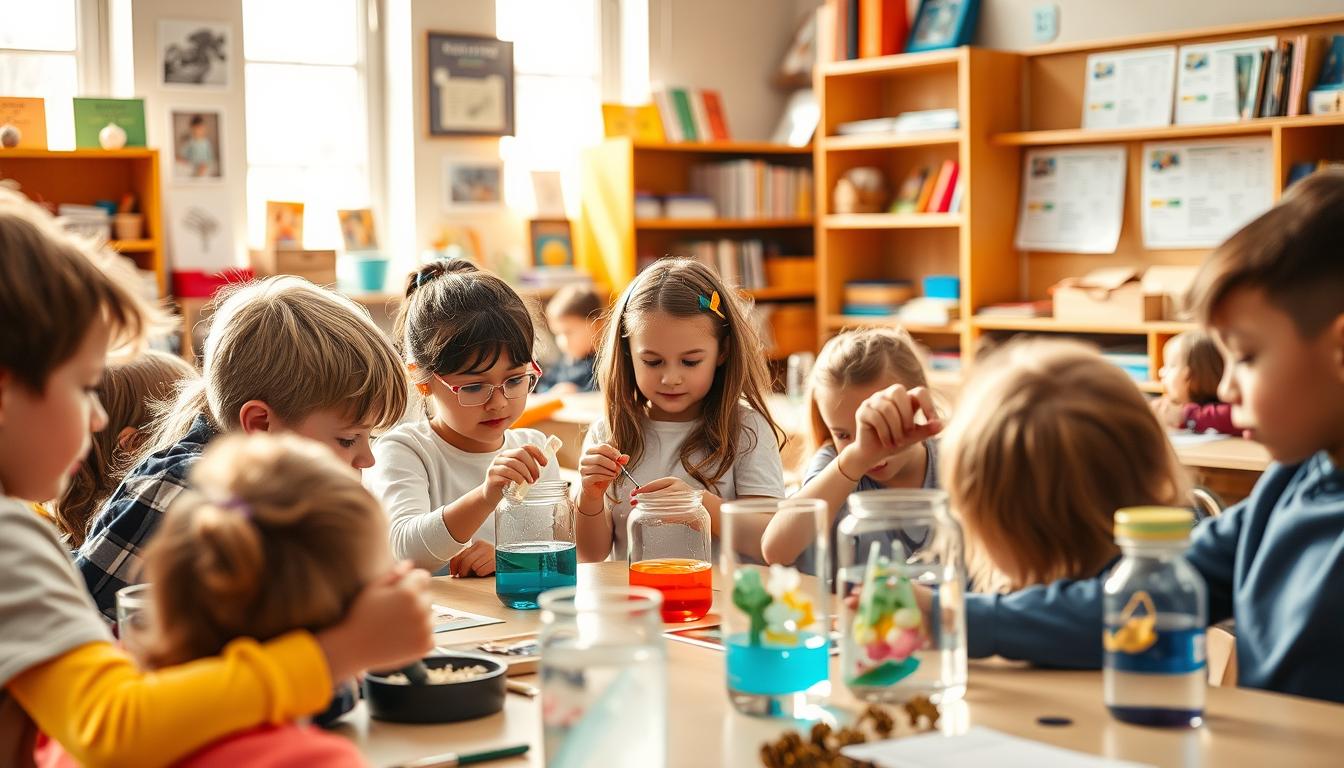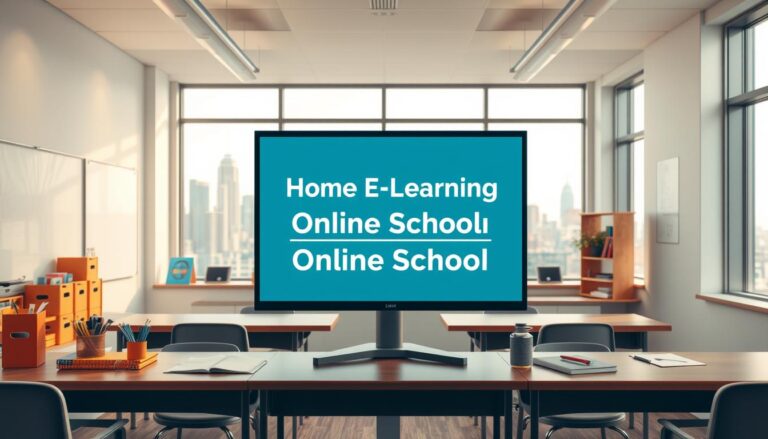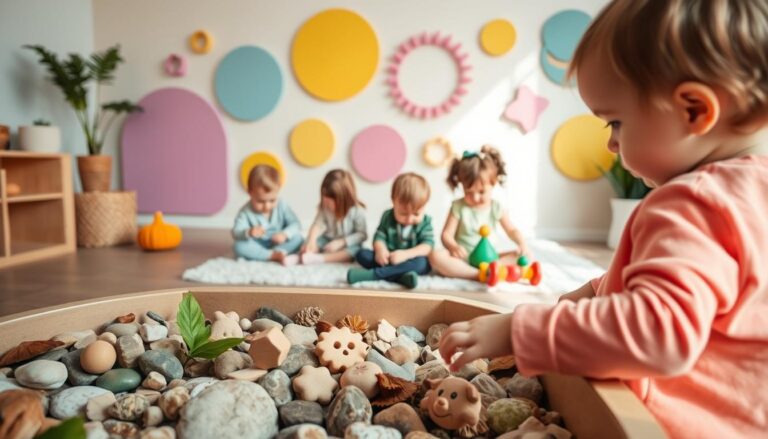Science Discovery Activities for Early Learners
Have you ever wondered how simple household items can spark a lifelong love for learning? Early learners are naturally curious, and their minds thrive on exploration and discovery. We believe that engaging them with hands-on activities can lay the foundation for critical thinking and creativity.
Using everyday materials like water and baking soda, we can create fun and educational experiences. These activities are designed to be safe, simple, and memorable. They not only entertain but also help children develop observational skills and a deeper understanding of the world around them.
Our approach is rooted in proven methods that encourage play-based learning. By turning curiosity into action, we empower young minds to explore, ask questions, and discover answers. Let’s dive into these exciting activities and see how they can make learning a joyful adventure!
Introduction to Early Science Discovery
Every day presents a new chance for young minds to explore and ask questions. Early discovery activities are a cornerstone of preschool education, helping children develop essential skills while having fun. By using simple materials like paper, vinegar, and soda, we can introduce basic principles in an engaging way.
Everyday items such as milk and mix also play a vital role in these activities. For example, mixing vinegar and baking soda creates a fizzy reaction that captivates a child’s attention. These experiments are not only entertaining but also educational, fostering curiosity and critical thinking.
Understanding the Importance of Curiosity in Learning
Curiosity drives children to explore their surroundings and ask questions. It’s the foundation of all learning. When we encourage this natural inquisitiveness, we help children build a lifelong love for discovery. Simple activities, like observing how paper absorbs water or how milk reacts with soap, spark wonder and understanding.
Our Approach to Engaging Young Minds
We tailor our activities to each child’s interests and age. This personalized approach ensures that every child feels engaged and motivated. By integrating hands-on learning into daily routines, we help children develop observational skills and a deeper understanding of the world. Our goal is to make learning a joyful and transformative experience.
| Material | Activity | Learning Outcome |
|---|---|---|
| Paper | Absorption Experiment | Understanding material properties |
| Vinegar | Chemical Reaction with Soda | Introduction to basic chemistry |
| Milk | Color Mixing with Soap | Observation of surface tension |
Toddler Science Experiments: Engaging Early Learners
Simple, everyday items can unlock a world of discovery for early learners. By using safe and familiar materials, we create activities that are both fun and educational. These experiments are designed to spark curiosity and encourage hands-on exploration.
Why We Love Simple and Safe Experiments
Safety is our top priority. We choose materials that are non-toxic and easy to handle, ensuring a worry-free experience for both children and parents. Simple experiments also allow for predictable outcomes, which build confidence and understanding.
For example, mixing food coloring with shaving cream creates a vibrant, sensory-rich activity. This not only teaches about color blending but also engages fine motor skills. Such activities are perfect for young learners who thrive on tactile experiences.
Incorporating Everyday Materials for Learning
Everyday items like cups, cream, and vinegar are the stars of our experiments. These materials are accessible and affordable, making them ideal for repeated use. For instance, a simple reaction between baking soda and vinegar in a cup can teach basic chemistry concepts.
We also use food items like milk and soap to demonstrate surface tension. These experiments are not only educational but also visually captivating, holding a child’s attention while they learn.
| Material | Activity | Learning Outcome |
|---|---|---|
| Shaving Cream | Color Mixing | Understanding color blending |
| Food Coloring | Milk Art | Observing surface tension |
| Cup | Baking Soda Reaction | Introduction to chemical reactions |
Water-Based Experiment Activities
Water is a fascinating medium for exploring natural principles in a hands-on way. These activities are designed to be both fun and educational, using simple materials to teach key concepts. From understanding density to creating visual effects, water-based experiments captivate young minds and encourage curiosity.
Exploring Water Density and Buoyancy
One of the simplest ways to teach density is by layering liquids in a bottle. For example, mixing water with sugar and food coloring creates a colorful density tower. This activity helps children visualize how different liquids interact based on their weight.
Buoyancy can be demonstrated using everyday items like oranges. An unpeeled orange floats, while a peeled one sinks. This experiment shows how density affects whether objects float or sink in water.
Magic Milk and Rain Cloud Demonstrations
Magic Milk is a fun way to explore surface tension. Add drops of food coloring to milk, then introduce dish soap. The soap breaks the surface tension, creating a swirling effect that mesmerizes children.
Rain cloud demonstrations use shaving cream and colored water to mimic precipitation. Adding drops of water to the shaving cream “cloud” shows how rain forms. This activity is both visually engaging and educational.
| Material | Activity | Learning Outcome |
|---|---|---|
| Water and Sugar | Density Tower | Understanding liquid density |
| Milk and Soap | Magic Milk | Observing surface tension |
| Shaving Cream | Rain Cloud | Learning about precipitation |
These experiments are designed to be safe and simple, making them perfect for home or classroom use.
Fun with Chemical Reactions and Creative Materials
Discover how everyday items can transform into exciting learning tools through creative chemical reactions. These activities are designed to captivate young minds while teaching essential concepts in a fun and interactive way. By using simple materials, we can create memorable experiences that inspire curiosity and exploration.
Transformative Reactions with Baking Soda and Vinegar
One of the most popular activities involves baking soda and vinegar. When these two materials mix, they create a fizzy reaction that kids find magical. This simple experiment introduces basic chemistry concepts in an engaging way.
Here’s how to do it:
- Place baking soda in a bowl or cup.
- Add vinegar slowly using a spoon to control the reaction.
- Observe the bubbles and discuss what’s happening.
This activity teaches kids about chemical reactions and the release of carbon dioxide. It’s a perfect example of how everyday materials can be used for learning.
Using Color and Texture for Interactive Learning
Color and texture add an extra layer of excitement to science activities. For instance, mixing food coloring with shaving cream creates a vibrant, sensory-rich experience. Kids can explore color blending while developing fine motor skills.
Another idea is to use milk and soap to demonstrate surface tension. Add drops of food coloring to milk, then introduce dish soap. The soap breaks the surface tension, creating a swirling effect that mesmerizes children.
These activities not only entertain but also reinforce key scientific principles. They show how creative materials can make learning both fun and educational.
By incorporating these hands-on experiments into daily routines, we help kids develop a deeper understanding of the world around them. These activities are designed to be safe, simple, and accessible, making them ideal for home or classroom use.
Hands-On STEM Challenges and Engineering Explorations
What if everyday items could turn into tools for building and engineering? We believe that simple supplies can inspire young minds to solve real-world problems. By using materials like paper, jars, and rubber bands, we can create engaging projects that teach essential concepts.
Building Bridges, Boats, and Catapults with Simple Supplies
Building bridges is a great way to introduce the concept of structural engineering. Using straws and tape, kids can design and test their creations. Boats made from recycled materials teach buoyancy and density. Catapults, crafted with popsicle sticks and rubber bands, demonstrate force and motion.
Here’s how to get started:
- Gather materials like straws, tape, and recycled items.
- Encourage kids to sketch their designs before building.
- Test each creation and discuss what works and what doesn’t.
Capillary Action and the Magic of Plant Experiments
Capillary action can be explored using a jar of water and food coloring. Place a celery stalk in the jar and watch as the color travels up the stem. This simple experiment teaches how plants absorb water and nutrients.
Another fun activity is growing seeds in a jar. Kids can observe the roots and shoots as they develop. These projects help children understand the basics of plant biology and the importance of water in growth.
Engineering Projects to Spark Problem Solving
Engineering projects like building a water filter or a cell phone stand encourage critical thinking. These activities require kids to solve problems and test their solutions. For example, creating a water filter involves understanding filtration and purification concepts.
We also recommend the egg drop challenge. Kids design a protective enclosure for an egg and test it by dropping it from a height. This project teaches impact resistance and material science.
These hands-on STEM challenges are perfect for home or classroom use. For more ideas, check out our online learning program, which offers interactive activities for early learners.
Integrating Science into Daily Learning Environments
How can everyday moments become opportunities for discovery and learning? By weaving simple experiments into daily routines, we can make abstract concepts tangible and engaging. These activities not only teach key principles but also foster a natural curiosity in young minds.
One effective way to integrate science is through colorful experiments. For example, creating a rainbow effect using water, light, and a prism demonstrates how light refracts. Such activities captivate attention while teaching fundamental concepts. Chemical reactions, like mixing baking soda and vinegar, also offer hands-on learning opportunities.
Enhancing Our Teaching with Everyday Experiments
Simple demonstrations, such as capillary action experiments, can enrich both classroom and home environments. Watching water travel up a paper towel or celery stalk teaches absorption and plant biology. These activities are easy to set up and leave a lasting impression.
Here are some practical ways to incorporate science into daily learning:
- Use household items like vinegar, baking soda, and food coloring for safe, engaging experiments.
- Create a rainbow jar by layering liquids of different densities to teach about buoyancy.
- Explore capillary action by observing how water moves through materials like paper or plants.
These activities not only spark curiosity but also encourage further inquiry. One experiment often leads to questions and more exploration, creating a cycle of learning. By integrating science into daily routines, we help children see the world through a lens of wonder and discovery.
Everyday scientific activities stimulate a sustained interest in learning. They transform ordinary moments into extraordinary opportunities for growth and understanding. Let’s make science a natural part of every day!
Conclusion
Engaging young minds with hands-on activities can shape their understanding of the world. Simple experiments, like exploring surface tension with soap, teach fundamental concepts in a fun and interactive way. These activities not only spark curiosity but also build essential skills like observation and problem-solving.
We encourage educators and parents in India to integrate these experiments into daily routines. By using everyday materials, you can create memorable learning moments that inspire a love for discovery. From observing capillary action to mixing colorful solutions, each activity offers a chance to explore and learn.
Our commitment is to provide safe, accessible, and innovative ways to nurture curiosity. Let’s continue to empower young learners by turning everyday moments into opportunities for growth and understanding. Together, we can make learning a joyful and transformative experience.







